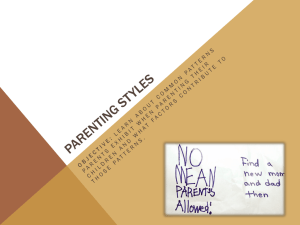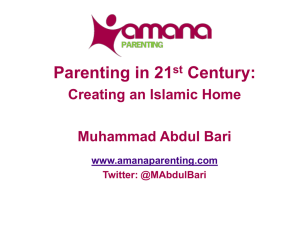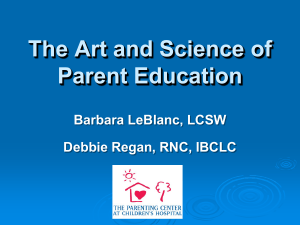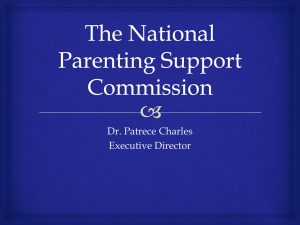Parenting Style and Problem Behaviors
advertisement
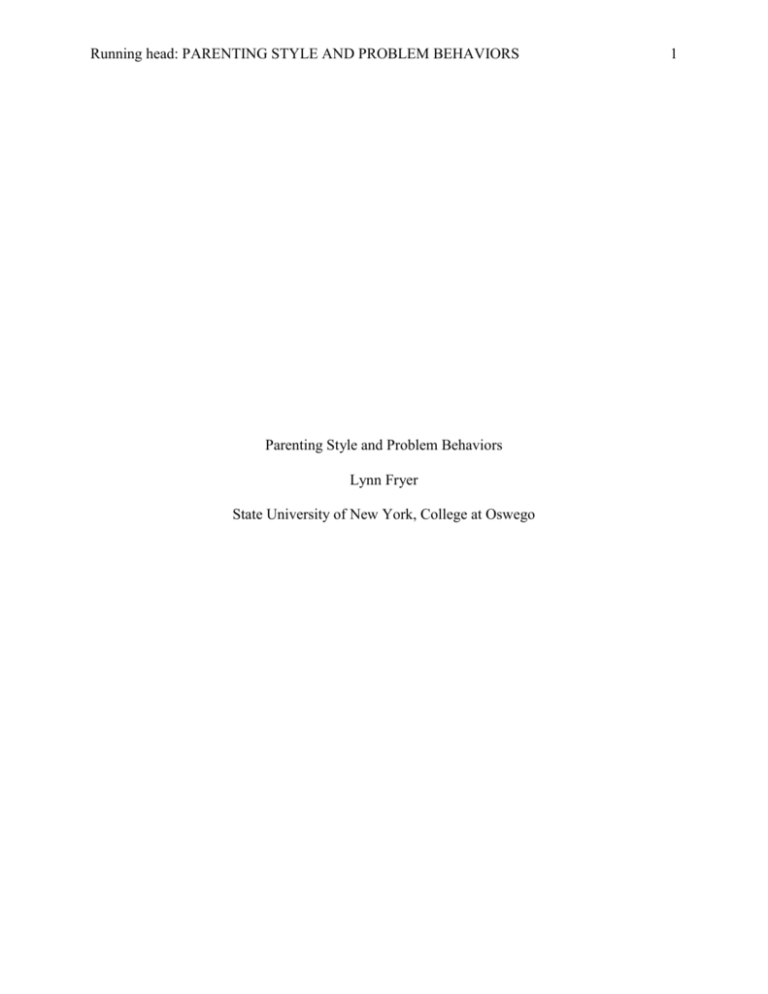
Running head: PARENTING STYLE AND PROBLEM BEHAVIORS Parenting Style and Problem Behaviors Lynn Fryer State University of New York, College at Oswego 1 PARENTING STYLE AND PROBLEM BEHAVIORS 2 Parenting Style and Problem Behaviors There are two common categories of problem behaviors that occur in children and adolescents: externalizing and internalizing. Externalizing problem behaviors include those that are manifested outwardly, such as hyperactivity, aggression, and drug and alcohol use. Internalizing problem behaviors refer to those that are directed inwardly, including anxiety, depression, and somatic complaints. The occurrence of these problem behaviors can be influenced by nature, or genes that predispose an individual to these types of behaviors, as well as nurture, or environmental influences. Research has also shown that girls have an increased risk for developing internalizing behaviors, while boys have an increased risk for developing externalizing behaviors (Leadbeater, Kuperminc, Blatt, & Hertzog, 1999). One environmental aspect that is associated with problem behaviors, whether externalizing or internalizing, is parenting style. The type of parenting style that adults engage in, as well as the child’s perception of parenting style, can influence problem behaviors. Maccoby and Martin (1983) defined two dimensions of parenting: acceptanceresponsiveness and demandingness-control. Parental acceptance-responsiveness refers to the extent to which parents are supportive, sensitive to their children’s needs, and willing to provide affection and praise. Parental demandingness-control refers to how much control over decisions lies with the parent rather than the child. By crossing these two dimensions, four parenting styles can be described. Authoritarian parenting is a combination of low acceptance-responsiveness and high demandingness-control. This is a restrictive parenting style in which parents set many rules, expect strict obedience, do not explain why the child should comply with rules, and may resort to power tactics to gain compliance. Authoritative parenting is a combination of high acceptance-responsiveness and high demandingness-control. With this style, parents are more PARENTING STYLE AND PROBLEM BEHAVIORS 3 flexible. They set rules and expect compliance, but explain the rationale behind each rule. Parents also involve their children in family decision making and communicate respect for their children. Permissive, or indulgent, parenting is a combination of high acceptance-responsiveness and low demandingness-control. These parents encourage their children to express their feelings, but make few rules and rarely exert control over their children’s behavior. Neglectful, or uninvolved, parenting is a combination of low acceptance-responsiveness and low demandingness-control. These parents do not seem to care much about their children and may even reject them (Sigelman & Rider, 2012). These parenting styles are thought to influence long-term behavioral outcomes of individuals. In a 12 year study conducted by Luyckx et al. (2011), the authors sought to determine how different parenting styles accounted for differences in developmental trajectories of behaviors (externalizing and internalizing) across childhood and adolescence. They identified the four parenting styles, as described by Maccoby and Martin (1983), based on parent reports of positive parenting, monitoring/supervision, and inconsistent discipline. The authoritarian class was identified by high scores on monitoring/supervision, and low scores on positive parenting and inconsistent discipline. The authoritative class was identified by high scores on positive parenting and monitoring/supervision, and low scores on inconsistent discipline. The indulgent (permissive) class was identified by high scores on positive parenting and inconsistent discipline and low scores on monitoring/supervision. The uninvolved (neglectful) class was identified by high scores on inconsistent discipline and low scores on positive parenting and monitoring/supervision. While parent reports were considered when determining parenting style, child reports were used when determining the occurrence of certain behaviors. These behaviors PARENTING STYLE AND PROBLEM BEHAVIORS 4 included alcohol and cigarette use, antisocial behavior, and internalizing behaviors (Luyckx et al., 2011). With respect to authoritarian parenting, Luyckx et al. (2011) found that monitoring and supervision were high during childhood and then decreased during adolescence. Low positive parenting was noticed in childhood, which decreased as the children transitioned into adolescence. There were also low reports of inconsistent discipline during childhood, which remained stable across adolescence. Children of authoritarian parents reported an increase in alcohol use, cigarette use, and internalizing symptoms from childhood to adolescence. Their reports of antisocial behavior remained stable. The authors concluded that authoritarian parenting may protect against externalizing behaviors, but may result in increased internalizing behaviors (Luyckx et al., 2011). For authoritative parenting, monitoring and supervision were high in childhood and increased throughout adolescence. High positive parenting was found in childhood, although there was a slight decrease across adolescence. There were low reports of inconsistent discipline in childhood, which remained stable throughout adolescence. Children of authoritative parents reported slight increases in alcohol and cigarette use across adolescence. Their reports of antisocial behavior were low in childhood and remained stable throughout adolescence. There was a slight increase in internalizing symptoms throughout childhood, but were followed by decreases in adolescence. The authors concluded that children of authoritative parents fared better than their peers in terms of maladaptive behaviors (Luyckx et al., 2011). With respect to indulgent (permissive) parenting, monitoring and supervision were moderate during childhood, but greatly decreased during adolescence. Reports of positive parenting were high during childhood, but slightly decreased across time. There were high PARENTING STYLE AND PROBLEM BEHAVIORS 5 reports of inconsistent discipline during childhood, which continued to increase across adolescence. Children of indulgent parents reported increases in alcohol and cigarette use, antisocial behavior, and internalizing symptoms throughout childhood and adolescence. The authors concluded that there were disadvantages to being a child of indulgent parenting: increases in both externalizing and internalizing behaviors (Luyckx et al., 2011). For uninvolved (neglectful) parenting, the authors found that already low reports of monitoring and supervision during childhood continued to decrease throughout adolescence (Luyckx et al., 2011). Positive parenting scores were also low during childhood, but continued to decrease across time. Reports of inconsistent discipline remained high throughout adolescence. Children of uninvolved parents reported steep increases in alcohol and cigarette use, antisocial behavior, and internalizing symptoms across childhood and adolescence. The authors concluded that these children fared the worst when compared to their peers (Luyckx et al., 2011). Another study proposes that a child’s temperament, or innate aspects of an individual’s personality, along with parenting style can influence behavior problems (Williams et al., 2009). This study suggests that nature and nurture are involved in long-term behavioral outcomes of individuals. The authors looked specifically at one type of temperament, behavioral inhibition. This temperament includes negative emotionality in childhood, withdrawn behavior in response to novelty in toddlerhood, and social reticence in preschool and later childhood (Williams et al., 2009). In this study, children were assessed for behavioral inhibition at 14 months and again at 24 months, in a lab setting. Mothers self-reported their parenting style when their child was 7years-old by completing a questionnaire. Only three parenting styles were defined: authoritarian, authoritative, and permissive. Mothers also completed a checklist when their children were ages PARENTING STYLE AND PROBLEM BEHAVIORS 6 4, 7, and 15, in order to determine behavior problems, whether externalizing or internalizing. The authors predicted that behavioral inhibition would relate to more internalizing problems. They also predicted that negative parenting (authoritarian and permissive) would correlate to higher externalizing and internalizing problems. In addition, it was also hypothesized that the combination of behavioral inhibition and negative parenting would result in an increase of behavior problems (Williams et al., 2009). When behavioral inhibition was the only component being considered, it was found that children with behavioral inhibition had more internalizing behaviors. Those children with higher behavioral inhibition scores had more internalizing problems at age 4 and maintained their levels. Those with lower behavioral inhibition scores had fewer internalizing problems at age 4, but increased in internalizing problems over time. It was also found that behavioral inhibition was not significantly related to externalizing problems. Children assessed with higher behavioral inhibition scores showed sharp decreases in externalizing problem behaviors over time (Williams et al., 2009). With respect to parenting styles, only permissive parenting was significantly related to levels of internalizing behaviors in children. In addition, only authoritarian parenting significantly corresponded to an increase in externalizing behaviors (Williams et al., 2009). This appears inconsistent with findings from Luyckx et al. (2011). They found that permissive parenting led to an increase in both internalizing and externalizing behaviors, while authoritarian parenting led to an increase in internalizing behaviors, but protected against externalizing behaviors. Further research is necessary to determine which parenting style is associated with a more significant increase in externalizing versus internalizing problem behaviors. In addition, Luyckx et al. (2011) described a fourth parenting style that was not described in this study: PARENTING STYLE AND PROBLEM BEHAVIORS 7 uninvolved (neglectful). Uninvolved parenting also appears to be related to increases in both externalizing and internalizing behaviors. When behavioral inhibition and parenting style were both considered, an interaction between high behavioral inhibition in children and permissive parenting related to an increase in internalizing behaviors. In addition, there was no significant interaction of one parenting style with high behavioral inhibition which predicted higher levels of externalizing behaviors (Williams et al., 2009). The authors concluded that over time, those children displaying high behavioral inhibition showed an increase in levels of internalizing problems, while the levels of externalizing problems decreased. This pattern is similar to those found in normative, nonclinical samples, suggesting that even those children with extreme temperaments show typical longitudinal patterns of behavior problems. They also found that negative parenting (permissive and authoritarian) may increase the risk of problem behaviors in children with extreme temperaments (behavioral inhibition). Authoritative parenting is thought to lessen problem behavior. In addition, the authors concluded that authoritarian parenting might have opposite effects for those children with high behavioral inhibition. These children may be better able to develop positive social behavior and develop ways to cope that counteract the development of externalizing behaviors (Williams et al., 2009). The definition of behavioral inhibition alludes to internalizing problem behaviors in the future. It may be interesting to look at other temperaments that may allude to externalizing problem behaviors to see if externalizing and internalizing problems may occur in the future. The way a child perceives their parent or caregiver’s parenting style can also be a factor in the development of externalizing or internalizing behaviors. Yahav (2006) sought to examine PARENTING STYLE AND PROBLEM BEHAVIORS 8 the relationship between problem behaviors in children and their perception of three aspects of the parent-child relationship: parental rejection, overprotective behavior, and favoritism. Parental rejection is manifested in different types of behavior, including lack of parental warmth and affection, overt hostility and aggression, and inattention or neglect. These behaviors seem to be consistent with the authoritarian and neglectful parenting styles described by Maccoby and Martin (1983). Children who feel rejected by their parents may display more hostility and aggression, emotional instability, and low self-esteem. Overprotection is described as a high degree of physical and social contact with the child, being overly concerned about the child, and preventing independent behavior. This behavior appears consistent with some aspects of authoritarian and authoritative parenting styles. It has been shown that overprotective parenting may be associated with higher levels of anxiety in the child. Parental favoritism occurs when a parent shows greater warmth, intimacy, admiration, and interest towards one child. The preferred child may develop feelings of uniqueness and grandiosity, as well as guilt. The nonpreferred siblings may develop feelings of inferiority and hostility, as well as an excessive need for acceptance. Yahav (2006) expected children who perceived their parents as more overprotective, more rejecting, and as favoring would exhibit greater levels of problem behaviors. The Achenbach Youth Self-Report questionnaire was utilized to differentiate between externalizing, internalizing, and control children. The Family Relations Self-Report questionnaire was used to examine the relationships among family members from the child’s perspective. Siblings of children who met criteria for externalizing or internalizing symptoms were also asked to fill out the Family Relations Self-Report questionnaire (Yahav, 2006). PARENTING STYLE AND PROBLEM BEHAVIORS 9 When compared to non-symptomatic children, symptomatic children reported higher levels of parental rejection. Externalizing children reported higher levels of maternal rejection, however, both externalizing and internalizing children reported high levels of paternal rejection. Externalizing children reported more paternal favoritism of another sibling and higher levels of overprotection by fathers (Yahav, 2006). When symptomatic children were compared to their non-symptomatic siblings, significant differences were found. Non-symptomatic siblings perceived their symptomatic sibling as more overprotected by their parents, but less favored and less rejected by their parents. Symptomatic children perceived their siblings as more overprotected by their parents, more favored, and more rejected. It was found that symptomatic children viewed their parents more negatively, while their non-symptomatic siblings viewed their parents in a more positive light (Yahav, 2006). However, there were no parent reports of family relations. It may be necessary to determine if the child’s perception mirrors what is objectively occurring in the family in order to determine if the problem behaviors are a product of parenting style. Also, parenting styles were not described as Maccoby and Martin (1983) stated. In order to determine which parenting styles are associated with different behavioral outcomes, consistency definitions of parenting styles may be necessary. Externalizing or internalizing problem behaviors may also exist if the child perceives dissimilarity between maternal and paternal parenting styles. A dissimilarity could provide more trouble for the child in predicting their parents’ behavior. This puts the child at risk to develop learned helplessness, or the idea that external forces determine one’s destiny, which is associated with problem behaviors (Berkien, Louwerse, Verhulst, & van der Ende, 2012). Berkien, Louwerse, Verhulst, and van der Ende (2012) predicted that lower levels of perceived parental emotional warmth, higher levels of perceived rejection, and overprotection were associated with PARENTING STYLE AND PROBLEM BEHAVIORS 10 problem behaviors. They also hypothesized that perceived dissimilarity in the three domains would be associated with higher levels of internalizing and externalizing behaviors. Children and adolescents were asked to fill out one questionnaire to assess their mother’s parenting style and one questionnaire to assess their father’s parenting style. Parents were asked to fill out a checklist to assess internalizing and externalizing behavior in their children and adolescents. The authors found that all parenting styles are associated with externalizing problems, while rejection and overprotection are correlated with internalizing problems. It was also found that perceived dissimilarity in emotional warmth is associated with higher levels of problem behaviors, even if the child perceives one parent to show high emotional warmth. Perceived dissimilarity in overprotection is associated with higher levels of problem behaviors even if one parent is rated as not overprotective. In addition, perceived dissimilarity in rejection is associated with higher levels of internalizing problems (Berkien et al., 2012). The authors also found differences between ages and genders. As children got older, it was found that they perceived their parents as less warm, more rejecting, and more overprotective. Also, as the children got older, they perceived more dissimilarity in emotional warmth and overprotection. It was found that girls perceive more emotional warmth from their parents than boys do, but boys perceive more maternal rejection than girls do. In addition, girls were found to have higher internalizing problem scores than boys (Berkien et al., 2012). It appears that the future of parenting style research is focused on how parenting style and child/adolescent behavior affect each other. While most research focuses on the effect that parenting style has on a child or adolescent’s behavior, current studies are looking at the effects that a child’s behavior has on parenting style. This suggests that parenting style and child/adolescent adjustment have a cyclical nature. Kerr, Stattin, and Ozdemir (2012) developed PARENTING STYLE AND PROBLEM BEHAVIORS 11 a study to look at this cyclical effect. First, they created measures to assess behavioral control. Some contained questions that were based on parental knowledge of the child or adolescent’s behavior. Some measures excluded these questions. In addition, children were asked to fill out questionnaires based on parenting style, adjustment (including internalizing and externalizing behaviors), and information management, or how often children disclose information to their parents (Kerr, Stattin, & Ozdemir, 2012). It was found that including items on measures about parental knowledge resulted in stronger links to adolescent adjustment, rather than only asking questions about parent behavior (Kerr et al., 2012). Youths with authoritative parents were better adjusted on all measures than those with neglectful parents (Kerr et al., 2012), which is congruent with findings from Luyckx et al. (2011). The neglectful parenting style predicted increased delinquency and intoxication (externalizing behaviors). However, there were less consistent results for authoritarian and permissive parenting styles. It was also concluded that child and adolescent behavior could predict changes in parenting style. Both internalizing and externalizing behaviors, as well as low disclosure to parents predicted movement toward the neglectful parenting style. When children and adolescents did disclose to parents, movement was towards the authoritative style. The only gender differences occurred with delinquency, an externalizing behavior. This behavior predicted movement into the neglectful parenting style for girls, but not for boys. For boys, delinquency predicted movement out of the authoritative style, but did not show as strong of a movement toward neglectful parenting as with girls (Kerr et al., 2012). In order to move the area of parenting style research forward, a focus on the permissive and authoritarian parenting styles is necessary. It is clear that authoritative parenting results in well-adjusted children and neglectful parenting leads to increases in both internalizing and PARENTING STYLE AND PROBLEM BEHAVIORS 12 externalizing behaviors. However, it is unclear as to whether authoritarian and permissive styles are associated with more externalizing or internalizing behaviors. There is also not much information on how parenting style affects problem behaviors in each gender. It has been shown that girls are more at risk for internalizing problem behaviors, while boys are more at risk for externalizing problem behaviors (Leadbeater et al., 1999). However, many studies show no difference in the occurrence of problem behaviors when parenting style is considered. Future studies may consider using samples consisting of only one gender, or use larger samples so that a difference may be more noticeable. Since Kerr, Stattin, and Ozdemir (2012) found that parental knowledge resulted in stronger links to child adjustment, developing questionnaires with these types of questions may show more reliable results in terms of long-term behavioral outcomes. In addition, more longitudinal studies should be utilized when assessing how parenting styles and youth adjustment affect each other. Reports of parenting style should be completed more than once throughout future studies, as well. Parenting style is one environmental aspect that is associated with externalizing and internalizing problem behaviors. There are four commonly known parenting styles, which differ based on parental acceptance and demandingness: authoritarian, authoritative, permissive, and neglectful. Authoritative parenting seems to be associated with well-adjusted youths, with few externalizing or internalizing behaviors. On the other hand, neglectful parenting is correlated with sharp increases in both externalizing and internalizing behaviors. While studies suggest that authoritarian and permissive parenting styles are associated with problem behaviors, results have been inconsistent in determining if externalizing or internalizing are more prominent. In addition, the way a child or adolescent perceives parenting style can influence long-term behavioral outcomes, especially if parenting styles differ between the mother and father. A child PARENTING STYLE AND PROBLEM BEHAVIORS 13 who perceives parental rejection, overprotection, and favoritism, as well as differences in these behaviors between parents, may develop problem behaviors. Again, it is unclear as to whether externalizing or internalizing behaviors are more significant. Future research is suggested to further investigate the role of authoritarian and permissive parenting in problem behaviors and the distinction between externalizing and internalizing behaviors that result from each parenting style. Furthermore, parenting style does not appear to affect problem behaviors unidirectionally. Problem behaviors also seem to have an effect on how parents rear their children, suggesting that parenting style and problem behaviors have a cyclical nature. PARENTING STYLE AND PROBLEM BEHAVIORS 14 References Berkien, M., Louwerse, A., Verhulst, F., & van der Ende, J. (2012). Children's perceptions of dissimilarity in parenting styles are associated with internalizing and externalizing behavior. European Child & Adolescent Psychiatry, 21, 79-85. doi:10.1007/s00787-011-0234-9 Kerr, M., Stattin, H., & Ozdemir, M. (2012). Perceived parenting style and adolescent adjustment: Revisiting directions of effects and the role of parental knowledge. Developmental Psychology, 48(6), 1540-1553. doi:10.1037/a0027720 Leadbeater, B. J., Kuperminc, G. P., Blatt, S. J., & Hertzog, C. (1999). A multivariate model of gender differences in adolescents' internalizing and externalizing problems. Developmental Psychology, 35(5), 1268-1282. doi:10.1037/0012-1649.35.5.1268 Luyckx, K., Tildesley, E. A., Soenens, B., Andrews, J. A., Hampson, S. E., Peterson, M., & Duriez, B. (2011). Parenting and trajectories of children's maladaptive behaviors: A 12year prospective community study. Journal of Clinical Child & Adolescent Psychology, 40(3), 468-478. doi:10.1080/15374416.2011.563470 Maccoby, E. E., & Martin, J. A. (1983). Socialization in the context of the family: Parent-child interaction. In P. Mussen (Ed.), Handbook of child psychology (Vol. 4, pp. 1-101). New York, NY: Wiley. Sigelman, C. K., & Rider, E. A. (2012). Life-span human development. (7 ed., pp. 490-491). Belmont, CA: Wadsworth Cengage Learning. Williams, L. R., Degnan, K. A., Perez-Edgar, K. E., Henderson, H. A., Rubin, K. H., Pine, D. S., Steinberg, L., & Fox, N. A. (2009). Impact of behavioral inhibition and parenting style on internalizing and externalizing problems from early childhood through adolescence. Journal of Abnormal Child Psychology, 37, 1063-1075. doi:10.1007/s10802-009-9331-3 PARENTING STYLE AND PROBLEM BEHAVIORS 15 Yahav, R. (2006). The relationship between children's and adolescents' perceptions of parenting style and internal and external symptoms. Child: Care, Health and Development, 33(4), 460-471. doi:10.1111/j.1365-2214.2006.00708.x
